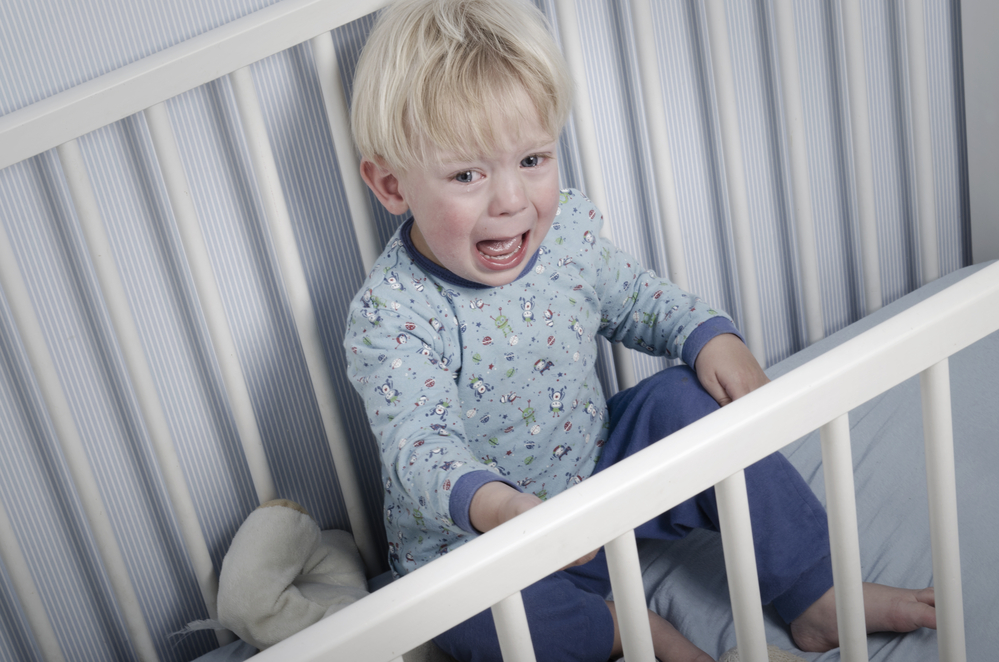There are a few times in your child’s life that separation anxiety will be at its worst. It can start as early as infancy, become more common in the 15-18 month range, and rear its ugly head again around 2. Preschoolers may also suffer from separation anxiety if they are going to a preschool for the first time. This separation anxiety around 2 coincides with the two year old sleep regression. Usually nap times and bedtime become a thing of dread and stress. The good news is night time separation anxiety doesn’t last forever.
As your child gets older they get more aware of object permanence. This is knowing that an object exists even when they don’t see it. So when your child doesn’t see you they know you are out there somewhere. This is good that your child is meeting this milestone and learning this so don’t get too discouraged. Separation anxiety is also showing your child is establishing a healthy attachment to their parent or caregiver.
With sleep regression separation anxiety your child may start to resist going to sleep or cry out for you multiple times a night for you. Your child at this stage in their life has no concept of time. They don’t know how long you have been away from them. Minutes and hours are all the same to them. Going to sleep may trigger their separation anxiety because this is usually the longest time they are alone.
When your usually great sleeper has all of a sudden started getting up multiple times a night or making you work extra hard to get them down it can be very easy to create some bad habits. This could be bringing them into your bed to sleep, or rocking them till they fall asleep and holding them for longer periods of time. Sometimes getting your child and soothing them is necessary when a full separation anxiety tantrum is upon you. But don’t make it to where every night you are getting them and bringing them into your bed. It doesn’t take long for your child to expect that behaviour to happen every night, and now you have a new normal.
If you are tackling bedtime with a spouse or another caregiver, come up with a game plan. Know what you both expect is acceptable and what boundaries you want to keep in line so that you are both working towards the same goal. If you are working against each other, and not making bed time consistent for your child it could cause more harm in the end, more confusion for your child, and more anxiety.
When dealing with separation anxiety make sure you remain calm. This can be very hard to do. You are tired, your child is tired, you just want them to sleep. It can be easy to snap, lose your control. Your child will feed off your emotions. So if you start a bedtime routine anxious, worried if they will have a melt down or not, chances are they will because they will feed off your anxiety.
Make bedtime calming and relaxing. Doing the same routine every night can also be helpful. Chaos and unpredictability can make your toddler even more anxious. Creating a routine that they will eventually know what is expected of them will help their bodies calm down and be ready for bed. They will know what is coming instead of being bedtime out of the blue.
It is never too late to introduce a new lovey or security object. If your child doesn’t have one, that is ok. Find one for them. It could be a special blanket they had at infancy. A favorite toy or stuffed animal. You could even take them to a store and pick out a special sleeping buddy if that’s what you feel will work best. Make sure your child has that with them when they go to sleep.
Sometimes when children wake up at night and it is pitch black in their room it can frighten them causing them to holler out for you. There are lots of different night light options you can put in your child’s room as well. Little glow aquariums that illuminate low, or fun character nightlights.
It may be time to reassess your child’s naps and bedtime schedules. Take a look at if they are getting too much sleep during the day, that at bedtime they aren’t tired enough to have a peaceful sleep they are ready for. Or if bedtime is too late they are overtired and harder to put down. It is ok to readjust your child’s schedule if needed.
When saying goodnight to them make sure you verbalize saying goodnight. Don’t try to sneak out of the room. Sneaking may cause your child to feel like you could vanish at any point causing their separation anxiety to become even worse. Keep your goodnights short. You can have a goodnight or goodbye special routine. Where they know when you say goodnight you always give them two kisses a big squeeze then it is done. This will help them know when you do these special routines that you are leaving at that they will be ok.
You can also practice being away from each other during the day. A trip to Grandma’s or have Grandma watch your child while you run a quick errand. This will show your child that you leave and come back to them. With it being while they are awake it will show them that you do come back when you say you are going to.
Make their room a positive sleep environment. This may mean not sending your child to their room as punishment, or putting them in time out in their crib. These negative associations with their room may make them more resistant or hesitant to going to bed. Set their room up with things they like, cars, horses, flowers, whatever they like. Make sure they have a comfortable bed, and put white noise or lullabies on if they prefer that. Playing regularly in their room with toys during the day will also help them have a positive association with their room.
Night time sleep regression does not last forever. It may feel like it does when you are handling it first hand. Remember it is a normal stage in your child’s life. It is positive that they are learning object permanence and growing a healthy attachment to their parents.
READ MORE: How To Fall Asleep Faster: Smart Tips For Healthy Sleep
Separation anxiety is not all bad. It is also showing your child is establishing a healthy attachment to their parent or caregiver. #HealthSurgeon
Making the bed time routine consistent will help eliminate confusion and anxiety!
Sources:
https://www.healthychildren.org/English/ages-stages/toddler/Pages/Soothing-Your-Childs-Separation-Anxiety.aspx
https://sleepingshouldbeeasy.com/separation-anxiety-at-night/
https://www.babysleepsite.com/sleep-training/baby-toddler-sleep-separation-anxiety/
https://www.parents.com/toddlers-preschoolers/starting-preschool/separation-anxiety/dealing-with-separation-anxiety/
https://www.yourmodernfamily.com/nighttime-separation-anxiety/
https://alphamom.com/parenting/toddler-parenting/two-year-old-bedtime-anxiety/
Did You Know?
- 1Looking to make extra money? We have Brand Partner openings on our team.
- 2Vitamins and Minerals in Purium are listed here
- 3You can Protect your gut bacteria from harmful glyphosate with this.
- 4Purium Health Products are organic and GMO free.
- 5The Biggest Purium Discount is available using our codes.









